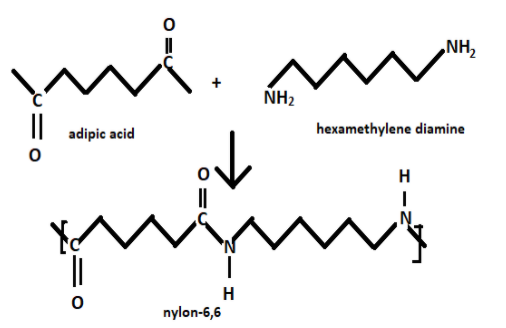
Give one example of a condensation polymer.
Answer
491.7k+ views
1 likes
Hint: First, we have to understand the condensation polymers. Condensation polymers are formed when the small monomeric units react with each other to form the larger polymeric units with a loss of water molecule.
Complete answer:
Let’s begin with the basic concept of polymerization. Polymerization is the process in which small monomer molecules react and form long-chain polymeric molecules. There are two types of polymerization: addition and condensation polymerization. When smaller monomers units react with each other to form polymer without any loss of water molecule is called as addition polymerization. While condensation polymers form with a loss of water molecules.
Condensation polymers form slowly as compared to the additional polymers because condensation polymer requires heat. It is a step-growth polymerization. The condensation polymers contain functional groups like amine, alcohol, carboxylic acid.

Nylon and polyesters are examples of the condensation polymers. When the monomers of hexamethylene diamine and adipic acid react with each other it gives the final product i.e., Nylon-6,6 and by-product water molecules. Nylon- 6,6 has 12 carbon units and it is used in making bristles for the brushes, sheets and in textile industries. It has greater resistance towards water, chemicals and heat.
Polyester forms by the reaction between glycol and dibasic acid. The by-product is also water that is mostly removed.
Note:
Nylon-6,6 is a polyamide that is formed by the condensation and step-growth polymerization. Remember nylon-6,6 is a light weight material so it is used in making parachutes. Do not confuse condensation polymerization with the elimination reaction as in condensation reaction, water molecules are eliminated.
Complete answer:
Let’s begin with the basic concept of polymerization. Polymerization is the process in which small monomer molecules react and form long-chain polymeric molecules. There are two types of polymerization: addition and condensation polymerization. When smaller monomers units react with each other to form polymer without any loss of water molecule is called as addition polymerization. While condensation polymers form with a loss of water molecules.
Condensation polymers form slowly as compared to the additional polymers because condensation polymer requires heat. It is a step-growth polymerization. The condensation polymers contain functional groups like amine, alcohol, carboxylic acid.

Nylon and polyesters are examples of the condensation polymers. When the monomers of hexamethylene diamine and adipic acid react with each other it gives the final product i.e., Nylon-6,6 and by-product water molecules. Nylon- 6,6 has 12 carbon units and it is used in making bristles for the brushes, sheets and in textile industries. It has greater resistance towards water, chemicals and heat.
Polyester forms by the reaction between glycol and dibasic acid. The by-product is also water that is mostly removed.
Note:
Nylon-6,6 is a polyamide that is formed by the condensation and step-growth polymerization. Remember nylon-6,6 is a light weight material so it is used in making parachutes. Do not confuse condensation polymerization with the elimination reaction as in condensation reaction, water molecules are eliminated.
Latest Vedantu courses for you
Grade 11 Science PCM | CBSE | SCHOOL | English
CBSE (2025-26)
School Full course for CBSE students
₹41,848 per year
Recently Updated Pages
Basicity of sulphurous acid and sulphuric acid are

Master Class 12 Economics: Engaging Questions & Answers for Success

Master Class 12 Maths: Engaging Questions & Answers for Success

Master Class 12 Biology: Engaging Questions & Answers for Success

Master Class 12 Physics: Engaging Questions & Answers for Success

Master Class 4 Maths: Engaging Questions & Answers for Success

Trending doubts
Give 10 examples of unisexual and bisexual flowers

Draw a labelled sketch of the human eye class 12 physics CBSE

a Tabulate the differences in the characteristics of class 12 chemistry CBSE

Differentiate between homogeneous and heterogeneous class 12 chemistry CBSE

Why is the cell called the structural and functional class 12 biology CBSE

Differentiate between insitu conservation and exsitu class 12 biology CBSE




